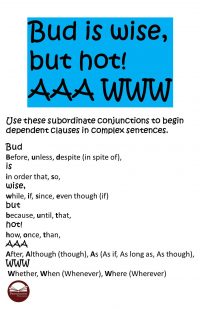How to Improve Your Writing Style with Grammatical Sentence Openers
One of the best ways to improve your writing style is to improve the variety of your sentence structures. Professional writers vary the subject-verb-object pattern with other grammatical sentence structures. A simple guideline for good sentence variety would be 50% subject-verb-object sentence openers and 50% other grammatical sentence opener forms.
Prepositional Phrase
Start with a phrase beginning with one of these common prepositions to improve writing style:
aboard, about, above, according to, across, after, against, along, among, around, as, as to, at, before, behind, below, beneath, beside, between, beyond, but, by, despite, down, during, except, for, from, in, inside, instead of, into, in place of, in spite of, like, near, next, of, off, on, onto, outside, out of, over, past, regardless of, since, than, through, throughout, to, toward, under, underneath, unlike, until, up, upon, with, within, without
Place a comma after a prepositional phrase sentence opener when a noun or pronoun follows.
Example:
Behind the cabinet, he found the missing watch.
Adjective
Start with a word or phrase that describes a proper noun, common noun, or pronoun with How Many? Which One? or What Kind? to improve writing style. Place a comma after an adjective or adjective phrase sentence opener.
Examples:
Angry, the neighbor refused to leave.
Happy as always, the child played in the park.
Adverb
Start with a word that answers these questions: How? When? Where? or What Degree? to improve writing style. Many adverbs end in __ly. Usually place a comma after an adverb sentence opener if the adverb is emphasized.
Example:
Everywhere, the flowers were blooming; quickly, the winter turned to spring.
Adverbial Clause
Start a dependent clause (a noun and verb that does not express a complete thought) with one of the following subordinating conjunctions to improve writing style:
after, although, as, as if, as long as, as much as, as soon as, as though, because, before, even if, even though, how, if, in order that, once, since, so that, than, that, though, unless, until, when, whenever, where, wherever, whether, or while.
Place a comma after an adverbial clause that begins a sentence.
Example:
Although better known for its winter activities, Lake Tahoe offers much during the summer.
__ed, __d, __t, or __en Participial Verb Forms
Start with a __ed, __d, __t, or __en verb, acting as an adjective, and/or add additional words to form a participial phrase. Usually place a comma after the sentence opener.
Examples:
Frightened, I sat up straight in my bed. Told to stop, the child finally did so.
Burnt to a crisp, the toast was horrible. Taken quickly, the pill did not dissolve for minutes.
To + Verb
Start with To and then add the base form of a verb to improve writing style. Add related words to create a phrase. Place a comma after the sentence opener, if a noun follows.
Examples:
To smile takes great effort.
To play the game, Mark had to sign a contract.
__ing Verbs and Nouns
Start a phrase with an __ing word that acts as an adjective to improve writing style. Usually place a comma after the sentence opener. Start a phrase with an __ing word that serves as a noun. Usually do not place a comma after the sentence opener.
Examples:
(Adjective)
Falling rapidly, the climber hopes the rope will hold.
(Noun)
Tasting the sauce makes them hungry for dinner.
Having Verbs and Nouns
Start a phrase with Having and then add a verb that ends in __d, __ed, or __en to serve as an adjective or a noun, referring to something that happened in the past to improve writing style. Usually place a comma after the sentence opener.
Examples:
(Adjective)
Having listened to his teacher, the student knew how to study.
(Noun)
Having learned all of the answers is helpful.
Noun Clause
Start with a group of words that acts as the subject of a sentence beginning with: How, However, What, Whatever, When, Whenever, Where, Wherever, Which, Whichever, Who, Whoever, or Whomever to improve writing style. Place a comma after the noun clause when used as a sentence opener if it does not serve as the subject of the sentence.
Example:
However the students answered, the scores were marked wrong.
Nominative Absolute
Start with a possessive pronoun (my, mine, our, your, his, her, or their) followed by a verb with a d, __ed, or __en ending to serve as a noun phrase that provides information, but no grammatical connection with the rest of the sentence. A comma is placed at the end of the nominative absolute when it opens a sentence.
Example:
His friends angry and frustrated, Paul promised to change his behavior.
Get the Grammatical Sentence Openers FREE Resource:
![]()
*****

TEACHING ESSAYS BUNDLE
The author’s TEACHING ESSAYS BUNDLE includes the three printable and digital resources students need to master the CCSS W.1 argumentative and W.2 informational/explanatory essays. Each no-prep resource allows students to work at their own paces via mastery learning. How to Teach Essays includes 42 skill-based essay strategy worksheets (fillable PDFs and 62 Google slides), beginning with simple 3-word paragraphs and proceeding step-by-step to complex multi-paragraph essays. One skill builds upon another. The Essay Skills Worksheets include 97 worksheets (printables and 97 Google slides) to help teachers differentiate writing instruction with both remedial and advanced writing skills. The Eight Writing Process Essays (printables and 170 Google slides) each feature an on-demand diagnostic essay assessment, writing prompt with connected reading, brainstorming, graphic organizer, response, revision, and editing activities. Plus, each essay includes a detailed analytical (not holistic) rubric for assessment-based learning.




